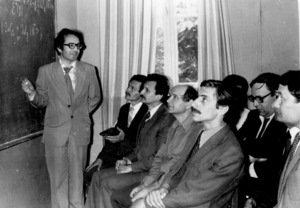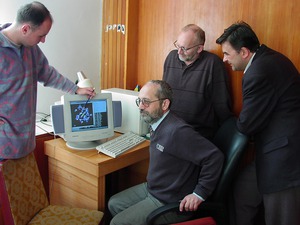Research / Main fundamental results / Theory of liquids and solutions
Theory of liquids and solutions
The studies in the field of the theory of liquids and solutions where initiated in 1960-70. The initial goal of these studies was to build a microscopic theory of electrolyte solutions with explicit account of the interactions between all particles of the system.  Due to explicit account for the ion-solvent interactions the theory builded was able to investigate and quantitatively describe screening effects, effects of ionic solvation, other important effects and phenomena and their dependence on the concentration and other parameters of the solution. The studies were based on the high oder cluster expansions for Helmholtz free energy and binary distribution functions of the ion-molecular systems. Later these methods were used to study molten salt and metal-salt systems (I.R.Yukhnovsky, M.F.Holovko, V.S.Vysochansky, I.J.Kuryljak, E.M.Sovjak, A.V.Popov, O.O.Pizio, A.D.Trokhymchuk, I.A.Protsykevytch).
Due to explicit account for the ion-solvent interactions the theory builded was able to investigate and quantitatively describe screening effects, effects of ionic solvation, other important effects and phenomena and their dependence on the concentration and other parameters of the solution. The studies were based on the high oder cluster expansions for Helmholtz free energy and binary distribution functions of the ion-molecular systems. Later these methods were used to study molten salt and metal-salt systems (I.R.Yukhnovsky, M.F.Holovko, V.S.Vysochansky, I.J.Kuryljak, E.M.Sovjak, A.V.Popov, O.O.Pizio, A.D.Trokhymchuk, I.A.Protsykevytch).
Currently the studies in the field of the theory of liquids and solutions cover the wide range of the systems and problems of the liquid state physics. Investigations are carried out using both original and well known statistical-mechanical methods (M.F.Holovko, Yu.V.Kalyuzhnyi, A.F.Kovalenko, Yu.J.Duda, E.V.Vakarin, T.G.Sokolovska, V.I.Kapko, M.Y.Druchok, T.M.Patsagan). In particular these methods include multidensity formalism used in the theory of the associating fluids. Application of this formalism allows to generelize the methods used in the theory of simple fluids and develop a theory for complex fluids, represented by the polymer and network forming fluids, self-associating fluids, etc.
Application of the multidensity formalism in the theory of electrolyte solution enables to generelize results obtained earlier for electrolytes dissolved in strongly and weakly polar solvents. In particular analytical expressions for Helmholtz free energy of the ion and ion-dipole systems, obtained in the framework of the associating mean spherical approximation are used as a basis for the theoretical description of the thermodynamic, kinetic and dielectric properties of nonaqueous electrolyte solutions. These results are used for description and interpretation of the experimental data on the osmotic coefficients and conductivity of electrolytes dissolved in the solvent with low dielectric permitivity. The theory developed is applied to study of the effects of electrolyte on the intramolecular electronic transport reactions in weakly polar solvents. It is demonstrated that formation of specific ionic pairs between charged donor or acceptor of the molecule and corresponding contrion in weakly polar electrolyte solutions causes the magnitude of the electronic transport to be droped up to several orders in the region of relatively low ionic concentrations. Theoretical predictions for intramolecular electronic transport dependence on the ionic concentration and on the donor-acceptor distance in electrolyte solutions have been verified experimentally using pulse radiolysis and laser photolysis methods to study reactions of charge permutation and photoinduced charge separation in donor-acceptor compounds, which were synthesized and investigated in Rutgers university (USA). Associative concept has been used for the interpretation of the experimental data for dielectric properties of the aqueous solutions of nitric and formic acids, which were obtained in the Institute of physical chemistry of Russian Acad. of Sci.. Systematic studies of the influence of cation valency on the structute of its hydration shell has been carried out. Loss of a certain number of hydrogen atoms was detected and interpreted as a manifestation of the effects of cationic hydrolysis. It is demonstrated that upon increase of the cationic valency its hydration structure, which consists of six oxygen atoms oktahedrally arranged around the cation, becomes more stable. The stability of the hydration structure causes the appearance of the new frequencies, which arise due to the combination of the vibrational oscillations of the hydration shell and librational movements of the water molecules coordinated by the cations. This effect was verified by the experimental studies carried out using Raman spectroscopy. It is shown that cation hydrolysis can cause formation of the polynuclear ionic complexes, which substantially effect thermodynamic and other properties of the solution in the wide range of the ionic concentrations, including the region of infinite dilution.
In the theory of associating fluids the methods of multidensity formalism were used to study of the effects of dimerization, polymerization and network forming clustering on the properties of the fluids. It is demonstrated that effects of polarization and network forming is manifested in the change of the structure factor form and appearance of the additional maximum in the short-wave region. These changes of the shape of the structure factor indicate the appearance of the mezoscopic ordering in the system. The existence of the liquid-gas critical point in the network forming fluids was detected even in the absence of the spherically symmetric attractive interactions. It is shown that the liquid phase region is a part of the percolation region, in which the size of the network formed cluster becames infinite. With the increase of the asymmetry in the strength of the longitudinal and cross network forming interaction the values of the critical temperature and density decreases. To describe the effect of cluster formation on the electronic structure of chemically reacting liquids integral equation method for configurationally averaged Green functions has been developed. As an example simle model of the alkali metal was used to demonstrate that due to dimerization conducting atomic fluid is transformed into nonconducting molecular fluid.
 On the base of the multidensity formalism the theory of molecular and macromolecular liquids has been proposed. It is shown that in the case of the two-density version of the formalism the theory developed reduces to the theory of Chandler-Silbey-Ladanyi. Systematic studies of the equilibrium properties of macromolecular liquids, which consist of the homo- and heteronuclear chain, star and ring macromolecules has been carried out. Using partially averaged version of the 6-dimensional Ornstein-Zernike equation for the central molecule in a molecular solvent 3-dimensional extension of the reference interaction site model (RISM) equation has been developed. This equation was used to describe hydrational structure of the molecules, ions, molecular surfactants and conformational forms of metenkephalin.
On the base of the multidensity formalism the theory of molecular and macromolecular liquids has been proposed. It is shown that in the case of the two-density version of the formalism the theory developed reduces to the theory of Chandler-Silbey-Ladanyi. Systematic studies of the equilibrium properties of macromolecular liquids, which consist of the homo- and heteronuclear chain, star and ring macromolecules has been carried out. Using partially averaged version of the 6-dimensional Ornstein-Zernike equation for the central molecule in a molecular solvent 3-dimensional extension of the reference interaction site model (RISM) equation has been developed. This equation was used to describe hydrational structure of the molecules, ions, molecular surfactants and conformational forms of metenkephalin.
Stability conditions for the equilibrium systems with spontaneous breaking of the symmetry has been formulated and their connection to the appearance of the Goldstone modes in the absence of the external field for anisotropic fluids has been established. Integral equation technique developed is used to describe anisotropic fluids with partially frozen orientational degrees of freedom. It was detected that due to spontaneous ordering harmonics of the correlation functions, which are perpendicular to the direction of the field and director have long-ranged character. It was shown that розорієнтуюче field icreases substantially of the ordered phase region and at high temperatures change the type of the phase transition. Substantial increase of the system elasticity due to the розорієнтуючого field is predicted.
Investigation of the structure and thermodynamic properties of the water and aqueous solutions has been carried out. The model used takes into account explicitely the formation of the hydrogen bonds between the water molecules. The theory developed correctly reprodece liquid-gas phase diagram for water and predict such anomaleous properties as existance of the maximum on the density vs temperature curve at normal pressure and properly describe temperature dependencies of the isothermal compressibility, thermal expansion coefficient and heat capacity. Ion-molecular approach in the theory of electrolyte solutions has been generelized for the aqueous solutions of oligoelectrolytes. Explanation of the peculiarities of thermodynamics of such systems (osmotic coefficients, enthalpy of dilution, etc), which can be observed experimentally, has been proposed. These peculiarities can not be explained in the framework of the traditional theories.
Theoretical description of the catalitic effects in electrolyte solutions due to complex formation caused by adding polyelectrolyte to the solution has been proposed. A model for polyion dimerization has been developed. In the framework of this model interpretation of the experimental data for the osmotic coefficients of the number of protein solutions, obtained using Donan equilibrium measurements, has been given.